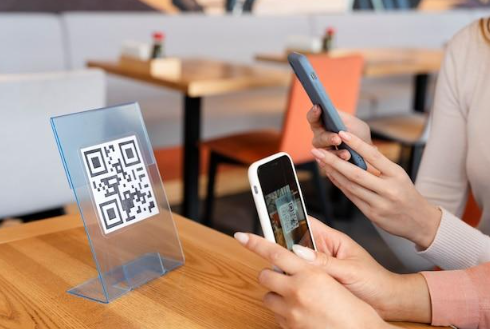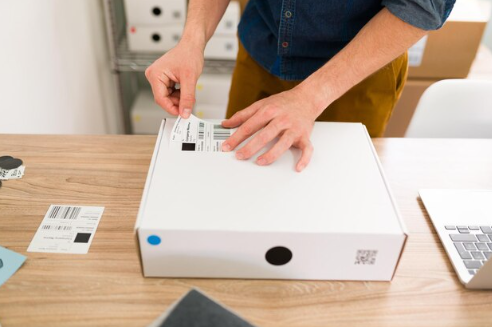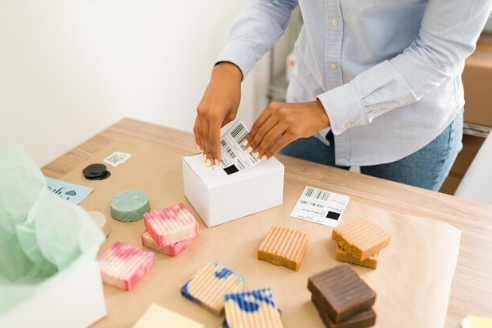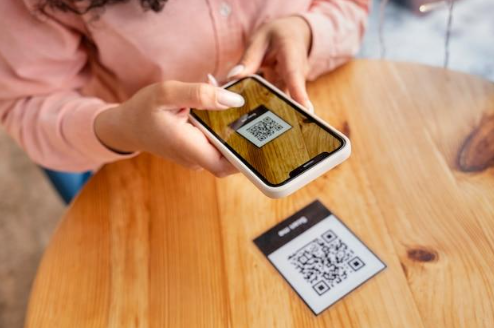What if the label on a bottle of shampoo or a box of cereal could do more than just list ingredients or carry a logo? What if it could tell you where the product came from, how it was stored, when it expires, or even offer you a discount—all with a simple scan? In today’s packaging environment, that’s not just a possibility—it’s quickly becoming the norm.
Rise in smartphone users scanning QR codes in retail settings, restaurants, and public eventspoint to a fundamental shift in how businesses and consumers interact with products through packaging.
Companies across industries are moving away from static, one-dimensional labels and toward smart labeling systems that do much more than display product information. These digital identifiers are transforming packaging into a bridge between physical products and the digital world—enhancing inventory tracking, improving customer engagement, and streamlining operations.
At the heart of this transformation is a company like DuraFast Label Company, which supplies the tools needed to print these intelligent labels—from high-quality color label printers to barcode printing software and affordable barcode scanners. Whether businesses are looking to upgrade their packaging with thermal barcode printers or adopt the best label design software for printers, DuraFast provides professional-grade solutions built for efficiency and reliability.
This blog outlines how RFID and QR codes are reshaping the future of packaging. We’ll look at how smart labels improve inventory management, help marketing teams connect with customers, and simplify the entire logistics process.
What Are Smart Labels?
Smart labels are an advanced version of traditional product labels. While a conventional label provides basic information like the brand, ingredients, or a barcode, a smart label includes a digital component—such as an RFID chip or a QR code—that adds functionality.
Types of smart labeling technologies:
·RFID tags: Use radio waves to transmit information stored in a microchip.
·QR codes: Square-shaped codes that can be scanned by a smartphone to access digital content.
·Data matrix codes: Similar to QR codes, often used in industrial and medical settings.
·NFC (Near Field Communication) tags: Allow close-range wireless communication, often seen in contactless payment systems.
These technologies enhance how products are tracked, sold, and interacted with—serving as gateways between physical items and digital data.
Why Smart Labels Are Gaining Traction

1. Supply Chain Transparency and Inventory Control
Managing inventory in real-time has long been a challenge for retailers and manufacturers. Smart labels provide a practical solution. RFID tags, in particular, allow businesses to scan entire pallets or shelves without the need for direct line-of-sight. This can dramatically reduce the time and errors associated with manual scanning.
Key inventory management benefits of RFID:
·Automatic inventory updates during goods movement.
·Real-time tracking of items from warehouse to retail shelves.
·Fewer stock discrepancies and reduced losses due to theft or misplacement.
·Enhanced accuracy in shipment verification.
With thermal barcode printers or color label printers, companies can print smart labels in-house, streamlining the labeling process and keeping operations efficient.
2. Retailers Optimizing Shelf Space and Replenishment
Smart labels allow store managers to make better decisions about stock placement and replenishment. For example, RFID-tagged merchandise can notify staff when shelves are running low or when high-value items have moved unexpectedly.
Some large retailers have reported shrinkage reductions of up to 25% after implementing RFID smart labeling, combined with affordable barcode scanners for routine shelf checks. That’s a significant impact, especially in sectors like apparel, electronics, or cosmetics.
3. Anti-Counterfeit and Product Authentication
·Counterfeit goods cost global industries billions each year. Smart labels help verify authenticity.
·With RFID or serialized QR codes, manufacturers can attach a unique identifier to every item. Customers or distributors can scan these identifiers to confirm if a product is genuine.
Smart labels can also:
·Help pharmaceutical companies track dosage authenticity.
·Enable electronics manufacturers to detect gray-market sales.
·Prevent luxury goods fraud by linking physical products to secure digital certificates.
4. Customer Engagement and Interactive Packaging
One of the most exciting features of QR code labels is how they enhance the customer experience. Brands are using QR codes to connect consumers with promotions, instructional videos, loyalty programs, and user manuals.
Interactive use cases for QR codes:
·Food packaging: Scan for recipe ideas or allergen info.
·Beverages: Link to vineyard or brewery tours.
·Electronics: Access how-to guides, warranty details, or firmware updates.
·Health products: Offer dosage reminders or product registration.
These aren’t gimmicks—they’re real enhancements that increase customer trust and satisfaction.
Companies can produce their own interactive packaging with barcode printing software, giving them control over design and messaging while cutting outsourcing costs.
5. Sustainability and Reduced Waste
Smart labels can also help companies reduce environmental impact.
·Digital receipts via QR codes eliminate the need for paper printouts.
·Track-and-trace capabilities prevent overproduction or misplacement, reducing waste.
·Smarter logistics means fewer returns, optimized transport, and more responsible sourcing.
Some QR code labels even contain recycling instructions or sustainability stats about the product—features that appeal to environmentally conscious consumers.
6. Speed and Efficiency in Logistics
RFID tags are especially valuable in logistics, where speed and precision are critical. Warehouses, logistics centers, and shipping hubs use RFID readers to process goods at high speed—no need for visual confirmation.
This technology significantly improves:
·Inbound and outbound shipping accuracy
·Cross-docking efficiency
·Load planning and route optimization
·Returns management
Combined with the best label design software for printers, businesses can customize their RFID label templates quickly, ensuring compliance with international standards and compatibility with automated systems.
7. Healthcare and Medical Safety
In the medical industry, errors can cost lives. Smart labels reduce those risks.
Hospitals and clinics use barcode labels and RFID to track patient medications, surgical instruments, and even patients themselves. Scanning the label ensures the correct dosage is administered to the correct patient.
Applications include:
·Bedside scanning for medication verification.
·QR-coded wristbands for patient history access.
·RFID-tagged surgical kits for real-time inventory during procedures.
Thermal barcode printers are often preferred in medical settings because of their reliability and ability to produce smudge-free, sterile labels.
8. Compliance and Traceability Across Industries

Governments and regulatory bodies increasingly demand traceability. Smart labels make compliance easier.
Industries like food, pharmaceuticals, and aerospace require traceability from origin to consumption. RFID and serialized QR codes provide a full audit trail, offering transparency that satisfies legal requirements and builds consumer trust.
For example:
·Pharmaceuticals: Track drugs from manufacturer to pharmacy.
· Food: Record temperature history during cold-chain logistics.
·Aerospace: Validate component certifications and maintenance history.
How to Implement Smart Labeling in Your Business
Transitioning to smart labels doesn’t require a complete overhaul. It can start small—with the right equipment and strategy.
Steps to Implement Smart Labeling:
1. Assess Your Labeling Needs
The first step is defining the purpose of your smart labels. Are you tracking inventory? Improving customer interaction? Ensuring product authenticity?
- RFID is ideal for logistics, asset tracking, and inventory management. It doesn’t require line-of-sight scanning and works great in bulk reading environments.
- QR codes, on the other hand, are perfect for consumer engagement—like directing customers to product pages, instructional videos, or promotional content.
Knowing what information you want to embed will help you determine the right tech.
2. Choose the Right Printing Hardware
Smart labeling isn’t one-size-fits-all.
- If you need color labels for retail shelves, customer packaging, or products on display, invest in a color label printer (like the Epson C6500 or Afinia L701). These make your QR codes part of a visually compelling design.
- For high-speed logistics or warehouse use, thermal transfer barcode printers (like Zebra or TSC models) are more efficient and economical, especially for monochrome barcodes or RFID tags.
The key is matching the printer to your label use case.
3. Use Barcode and Label Design Software
The software ties everything together. Tools like BarTender, NiceLabel, or Epson Label Editor enable:
- Variable data printing (e.g., serial numbers, batch info)
- Custom layouts with embedded QR/RFID info
- Easy integration with databases or ERP systems
Good software lets you scale without manual input every time.
4. Train Staff on Scanning & Protocols
Even the smartest labels need smart users. Staff should know:
- How to scan codes or tags using handheldbarcode scanners or RFID readers
- What to do if a scan fails
- How to troubleshoot common label printing or scanning issues
This reduces errors and keeps workflows smooth—especially in warehouses and fulfillment centers.
5. Test with a Pilot Program
Before going all in, test on a small batch of products or one department:
- Evaluate scanner compatibility
- Confirm label durability (especially if used outdoors or around chemicals)
- Get feedback from end users (staff or customers)
Once the kinks are worked out, expand to more areas.
Why In-House Printing Matters
Companies that print labels in-house gain:
- Speed: No waiting on third-party vendors
- Customization: Adapt label content quickly to product changes or regulations
- Cost control: Lower long-term costs for high-volume printing
Smart labeling is more effective when you’re in control of the process from design to application.
Businesses that handle their printing in-house have greater flexibility, better quality control, and quicker turnaround. Investing in the right tools makes smart labeling practical and cost-effective.

Barriers and Considerations Before Adopting
Despite the benefits, a few challenges must be considered:
·Initial investment: Hardware like RFID printers or barcode scanners can be expensive upfront.
·Label durability: Labels must withstand shipping, moisture, and temperature changes.
·Data security: QR codes that link to web content must be secured to prevent spoofing.
·Infrastructure readiness: Older facilities may need updates to handle RFID scanners or new barcode printing workflows.
However, these hurdles are often outweighed by long-term benefits. With smart implementation, even small to medium businesses can compete at the level of larger brands.
Industries Leading the Shift to Smart Labels
Certain sectors are already well into the adoption curve:
·Retail: Especially fashion, cosmetics, and grocery.
·Healthcare: For patient tracking, medication management, and asset management.
·Manufacturing: From electronics to aerospace, where precision and traceability are critical.
·Food and Beverage: For freshness tracking, customer engagement, and recalls.
·Logistics: Warehouses and shipping companies use RFID for fast, accurate movement.
Each of these industries uses a combination of color label printers, barcode printing software, and durable thermal barcode printers to meet the specific needs of their labeling environments.
What Could Your Packaging Say Tomorrow?
Packaging has long been an undervalued touchpoint in the customer experience. But with smart labels, it becomes a powerful communication and operational tool.
The future of product packaging is not just about better materials or prettier designs—it’s about intelligence. RFID tags and QR codes are transforming every label into a source of data, insight, and value.
For any business considering this transition, partnering with a reliable supplier is essential. DuraFastLabel Company provides not only high-performance printing hardware but also expert guidance on choosing the best label design software for printers, barcode printing systems, and scanners that suit your business model.
From producing QR code labels with vivid, professional color to printing durable RFID tags for logistics, DuraFast empowers companies to take control of their labeling process. Their printers support a wide range of applications and print media, helping you customize your packaging and streamline operations—without compromising quality.
Equip your business with the printing technology that keeps you competitive in a world where your label might just say more than your product.

